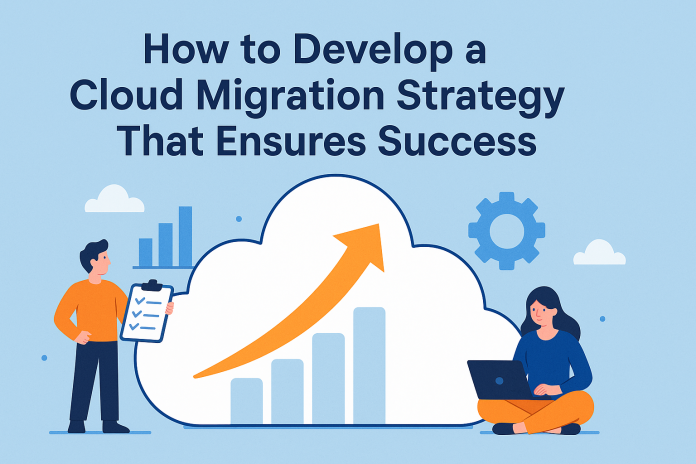How to Develop a Cloud Migration Strategy That Ensures Success
Moving to the cloud can transform your business operations. It allows you to become more flexible, improve performance, and reduce costs. But success doesn’t happen by chance. A strong, well-planned cloud migration strategy is essential to achieve real benefits.
In this blog, we will show you how to create a cloud migration strategy that works. We will cover key elements like cloud migration service, cloud application development services, and Microsoft Azure solutions.
1. Understand Your Business Goals First
Before starting, define why you’re migrating. Is it to improve performance? Lower costs? Scale faster?
Ask questions like:
- What business problems are we solving?
- Are there performance issues with current systems?
- Do we need better scalability or security?
These answers will guide every step of your cloud migration service plan. A clear goal aligns your technical efforts with real business value.
2. Evaluate Your Existing Infrastructure
Assess all your IT assets:
- Applications
- Databases
- Servers
- Storage systems
This will help you understand which systems are ready for migration, which need changes, and which should be retired.
Also, consider dependencies between applications. Some apps may rely on each other to function. Identifying these dependencies is key before choosing any cloud application development services.
3. Choose the Right Cloud Model
There are different types of cloud environments:
- Public Cloud: Easy to scale and cost-effective
- Private Cloud: More secure and customisable
- Hybrid Cloud: A mix of both
If you’re looking for strong security with flexibility, a hybrid model might be ideal.
Platforms like Microsoft Azure cloud solutions offer all three, giving you multiple options based on your business needs.
4. Select the Right Cloud Provider
Your cloud provider should meet your technical, business, and budget needs. Consider:
- Security features
- Compliance standards
- Cost structure
- Global reach
- Support and service levels
Microsoft Azure cloud solutions are popular because they work well with business tools. They also offer strong security and support for both Windows and Linux systems.
5. Build a Detailed Migration Plan
Your cloud migration service should include a clear step-by-step plan:
- Set a timeline
- Define who’s responsible for each task
- Set KPIs and success metrics
- Prepare backup and rollback procedures
Group workloads into categories like:
- Move-as-is (lift and shift)
- Modernise during migration
- Rebuild from scratch using cloud application development services
This helps prioritise work and reduce risks.
6. Choose the Right Migration Strategy
There are several common migration approaches:
- Rehosting (Lift and Shift): Moving applications without changing them
- Replatforming: Making slight changes to Optimise for cloud
- Refactoring: Redesigning apps using cloud application development services
- Retiring: Getting rid of outdated apps
- Retaining: Keeping some systems on-premises
The best approach depends on your goals, budget, and technical capabilities. For example, using Microsoft Azure cloud solutions allows a combination of these approaches for different parts of your business.
7. Focus on Security and Compliance
Security is not optional it’s a core part of your cloud strategy.
Make sure your cloud migration includes:
- Identity and access management
- Data encryption
- Secure APIs
- Compliance with standards like ISO, HIPAA, or GDPR
Cloud platforms like Microsoft Azure cloud solutions come with built-in tools to support strong security practises. Be sure your cloud migration service partner helps configure these properly.
8. Train Your Team
A successful migration requires people who know how to manage and use cloud tools.
Conduct training sessions on:
- Cloud basics and terminology
- Platform-specific tools
- New security practises
- Application management in the cloud
If you use cloud application development services, your team should know how to build and manage cloud-native apps.
9. Test Before and After Migration
Testing helps you avoid problems and downtime. Test everything:
- App performance
- Integration with other tools
- Security features
- Backup and disaster recovery
Create a staging environment that mirrors your production system. Use it to test your new cloud migration service setup before going live.
10. Monitor, Optimise, and Scale
Migration is not the final step it’s just the beginning.
After moving to the cloud:
- Monitor performance and costs
- Set alerts for security or downtime issues
- Use automation to scale resources as needed
Platforms like Microsoft Azure cloud solutions provide detailed analytics and AI tools to help you Optimise over time.
You can work with cloud application development services to improve applications. This can help with speed, scalability, and user experience.
11. Don’t Go It Alone Get Expert Support
Migrating to the cloud is complex. Partnering with experts in cloud migration service ensures smoother execution, reduced risk, and faster results.
These professionals can:
- Audit your existing systems
- Recommend the best strategy
- Handle the migration
- Provide ongoing support and updates
If you are moving or building applications, their cloud development services can be customized for you. This will help you get the most from your new environment.
Final Thoughts
Building a strong cloud migration strategy helps your business take full advantage of cloud technology. From understanding your needs to picking the right platform and planning the move, each step is important.
Use this guide as a starting point and remember to focus on your goals, security, and long-term success. Whether you’re choosing Microsoft Azure cloud solutions, enhancing apps through cloud application development services, or just looking for a reliable cloud migration service, the right strategy will set you up for lasting benefits.


